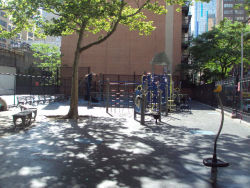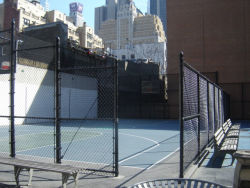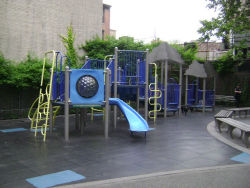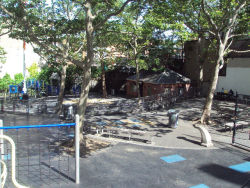McCaffrey Playground
McCaffrey Playground
What was here before?
After passing through a succession of owners during Dutch and British occupation, this property was part of a larger estate purchased in 1714 by the Hooper family. The estate remained in the family for several generations until Matthew Hooper sold it in 1786 to wealthy lawyer John George Leake as a country retreat. The estate and farm, known as the Hermitage, encompassed around 80 acres, and spanned from the Hudson to Bloomingdale Road (now Broadway). A Georgian style mansion was located close to this playground site.
Leake left the Hermitage Farm to his niece, Martha Norton who ultimately bequeathed it to her sons in 1797. John Leake Norton eventually subdivided and sold the land by 1825, and development was swift with the expansion of the street grid and train lines. A district of slaughterhouses, lumberyards, and factories, the neighborhood was also home to those working in these industries, many of whom were immigrants.
During the 1930s, the Church of the Holy Cross, which was established across the street in 1852, acquired half of this playground’s current footprint at the urging of Father McCaffrey, the park’s namesake. McCaffrey helped convince city officials that the space was urgently needed for neighborhood children and students at the Holy Cross School.
How did this site become a playground?
In 1938, following a Board of Estimate resolution, Parks Commissioner Robert Moses (1888-1981) approved the purchase of the space that the church had developed, as well as an adjoining lot, for park purposes. The next year, the City Council named the parkland McCaffrey Playground by a local law.
As with many of the playgrounds built by Robert Moses in the 1930s, the original design for McCaffrey Playground included a brick public restroom and pipe-frame swing sets. Play structures were added in the early 1980s. In 2002, the playground was reconstructed, and new play equipment, game tables, handball courts and a basketball court were added.
Who is this playground named for?
Monsignor Joseph A. McCaffrey (1890-1970), also known as “the Bishop of Times Square,” was the pastor of nearby Church of the Holy Cross for 36 years, and chaplain of the New York City Police Department for 30 years. A well-known crusader against crime and pornography in the Times Square area, McCaffrey helped convince Mayor Fiorello H. LaGuardia (1882-1947) to shut down neighborhood burlesque houses.
Joseph McCaffrey attended Fordham University in the Bronx and St. Joseph’s Seminary in Yonkers. He was ordained in 1916 and served as a priest in the Catholic Church for the remainder of his life. As a chaplain in the United States Army during World War I, McCaffrey was present during battles at Soissons, Aisne-Marne, Saint-Mihiel, Champagne, and the Argonne in France. The army awarded McCaffrey the Silver Star and the Croix de Guerre for his bravery and service. In 1941, he was granted the title of Monsignor.
Check out your park's Vital Signs
Clean & Safe
Green & Resilient
Empowered & Engaged Users
Share your feedback or learn more about how this park is part of a
Vital Park System




